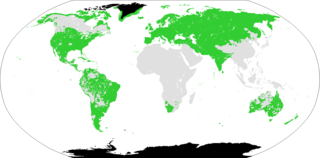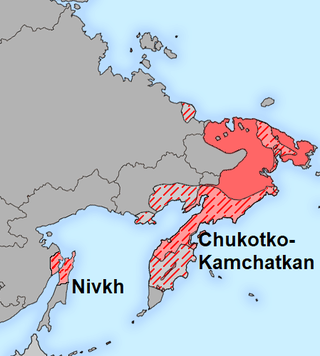
Nostratic is a hypothetical language macrofamily including many of the language families of northern Eurasia first proposed in 1903. Though a historically important proposal, it is now generally considered a fringe theory. Its exact composition varies based on proponent; it typically includes the Kartvelian, Indo-European and Uralic languages; some languages from the similarly controversial Altaic family; the Afroasiatic languages; as well as the Dravidian languages.

The Uralic languages form a language family of 42 languages spoken predominantly in Europe and North Asia. The Uralic languages with the most native speakers are Hungarian, Finnish, and Estonian. Other languages with speakers above 100,000 are Erzya, Moksha, Mari, Udmurt and Komi spoken in the European parts of the Russian Federation. Still smaller minority languages are Sámi languages of the northern Fennoscandia; other members of the Finnic languages, ranging from Livonian in northern Latvia to Karelian in northwesternmost Russia; and the Samoyedic languages, Mansi and Khanty spoken in Western Siberia.

Ural-Altaic, Uralo-Altaic, Uraltaic, or Turanic is a linguistic convergence zone and abandoned language-family proposal uniting the Uralic and the Altaic languages. It is generally now agreed that even the Altaic languages do not share a common descent: the similarities among Turkic, Mongolic and Tungusic are better explained by diffusion and borrowing. Just as Altaic, internal structure of the Uralic family also has been debated since the family was first proposed. Doubts about the validity of most or all of the proposed higher-order Uralic branchings are becoming more common. The term continues to be used for the central Eurasian typological, grammatical and lexical convergence zone.

The Eskaleut, Eskimo–Aleut or Inuit–Yupik–Unangan languages are a language family native to the northern portions of the North American continent, and a small part of northeastern Asia. Languages in the family are indigenous to parts of what are now the United States (Alaska); Canada including Nunavut, Northwest Territories, northern Quebec (Nunavik), and northern Labrador (Nunatsiavut); Greenland; and the Russian Far East. The language family is also known as Eskaleutian, Eskaleutic or Inuit–Yupik–Unangan.
The Paleo-Siberian languages are several language isolates and small language families spoken in parts of Siberia. They are not known to have any genetic relationship to each other; their only common link is that they are held to have antedated the more dominant languages, particularly Tungusic and latterly Turkic languages, that have largely displaced them. Even more recently, Turkic and especially Tungusic have been displaced in their turn by Russian.

The Chukotko-Kamchatkan or Chukchi–Kamchatkan languages are a language family of extreme northeastern Siberia. Its speakers traditionally were indigenous hunter-gatherers and reindeer-herders. Chukotko-Kamchatkan is endangered. The Kamchatkan branch is moribund, represented only by Western Itelmen, with only 4 or 5 elderly speakers left. The Chukotkan branch had close to 7,000 speakers left, with a reported total ethnic population of 25,000.

Dené–Caucasian is a discredited language family proposal that includes widely-separated language groups spoken in the Northern Hemisphere: Sino-Tibetan languages, Yeniseian languages, Burushaski and North Caucasian languages in Asia; Na-Dené languages in North America; and the Vasconic languages from Europe.

Eurasiatic is a hypothetical and controversial language macrofamily proposal that would include many language families historically spoken in northern, western, and southern Eurasia.

Indo-Uralic is a highly controversial linguistic hypothesis proposing a genealogical family consisting of Indo-European and Uralic.
Geographically, Siberia includes the Russian Urals, Siberian, and Far Eastern Federal Districts.

Borean is a hypothetical linguistic macrofamily that encompasses almost all language families worldwide except those native to the Americas, Africa, Oceania, and the Andaman Islands. Its supporters propose that the various languages spoken in Eurasia and adjacent regions have a genealogical relationship, and ultimately descend from languages spoken during the Upper Paleolithic in the millennia following the Last Glacial Maximum. The name Borean is based on the Greek βορέας, and means "northern". This reflects the fact that the group is held to include most language families native to the northern hemisphere. Two distinct models of Borean exist: that of Harold C. Fleming and that of Sergei Starostin.

Uralic–Yukaghir, also known as Uralo-Yukaghir, is a proposed language family composed of Uralic and Yukaghir.
Mosan is a hypothetical language family consisting of the Salishan, Wakashan, and Chimakuan languages of the Pacific Northwest region of North America. It was proposed by Edward Sapir in 1929 in the Encyclopædia Britannica. Little evidence has been adduced in favor of such a grouping, no progress has been made in reconstructing it, and it is now thought to reflect a language area rather than a genetic relationship. The term persists outside academic linguistic literature because of Sapir's stature.
Michael David Fortescue is a British-born linguist specializing in Arctic and native North American languages, including Kalaallisut, Inuktun, Chukchi and Nitinaht.
Dené–Yeniseian is a proposed language family consisting of the Yeniseian languages of central Siberia and the Na-Dené languages of northwestern North America.
Siberian languages may refer to any languages spoken in Siberia, including:
Proto-Eskaleut, Proto-Eskimo–Aleut or Proto-Inuit-Yupik-Unangan is the reconstructed common ancestor of the Eskaleut languages, family containing Eskimo and Aleut. Its existence is known through similarities in Eskimo and Aleut. The existence of Proto-Eskaleut is generally accepted among linguists. It was for a long time true that no linguistic reconstruction of Proto-Eskaleut had yet been produced, as stated by Bomhard (2008:209). Such a reconstruction was offered by Knut Bergsland in 1986. Michael Fortescue (1998:124–125) has offered another version of this system, largely based on the reconstruction of Proto-Eskimo in the Comparative Eskimo Dictionary he co-authored with Steven Jacobson and Lawrence Kaplan (1994:xi).

The Eskimo–Uralic hypothesis posits that the Uralic and Eskimo–Aleut language families belong to a common macrofamily. It is not generally accepted by linguists because the similarities can also be merely areal features, common to unrelated language families. In 1818, the Danish linguist Rasmus Rask grouped together the languages of Greenlandic and Finnish. The Eskimo–Uralic hypothesis was put forward by Knut Bergsland in 1959. Ante Aikio stated that it's possible that there exists some connection between the two families, but exact conclusions can't be drawn and the similarities could exist by loaning.

The Chukotko-Kamchatko-Amuric or Chukotko-Kamchatkan-Amuric languages form a hypothetical language family including Nivkh and Chukotko-Kamchatkan. A relationship between these two language groups was proposed by Michael Fortescue in a 2011 paper. He theorized that their common ancestor might have been spoken around 4000 years ago. However Glottolog says that the evidence is insufficient to conclude a genealogical relationship between Nivkh and Chukotko-Kamchatkan.












